Tourism in Romania
| Tourism in Romania | |
|---|---|
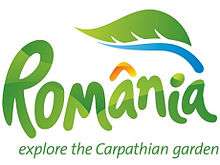 The official logo of Romania, used to promote the tourist attractions in the country | |
| Website | http://www.romania.travel/ |
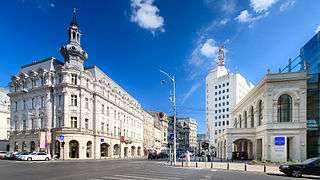
Tourism in Romania is focused on the country's natural landscapes and its history, and forms an important component of the economy of Romania. The total number of foreign tourist arrivals in the year 2014 was 1,911,800, an increase of 6.6% from the 2013 number of 1,714,500.[1] In 2014, Romania had 32,500 companies which were active in the hotel and restaurant industry, with a total turnover of EUR 2.6 billion.[2] However, the number of tourists has decreased dramatically in recent years, in fact, in 2004 there were 5,9 millions of tourists.[3] Only in 2012 the number of tourists has started to grow again.
The most visited cities are Bucharest, Brașov, Sibiu, Cluj-Napoca, Timișoara, Iași, and Constanța. The most significant natural attractions are the Danube, the Carpathian Mountains, and the Black Sea.
UNESCO World Heritage Sites in Romania
- Churches of Moldavia - The eight Romanian Orthodox Churches of Moldavia are located in Suceava County, northern Moldavia, and were built approximately between 1487 and 1583
- Dacian Fortresses of the Orăștie Mountains - The six fortresses (Sarmizegetusa Regia, Costeşti-Cetăţuie, Costeşti-Blidaru, Piatra Roşie, Bănița and Căpâlna) that formed the defensive system of Decebalus were created in the 1st centuries BC and AD as protection against Roman conquest, and played an important role during the Roman-Dacian wars
- Historic Centre of Sighișoara - It is an inhabited medieval citadel that was built in the 12th century by Saxon colonists under the Latin name Castrum Sex and it is the birthplace of Vlad III the Impaler also known by the name of Count Dracula
- Danube Delta - It is the second largest river delta in Europe and best preserved on the continent
- Monastery of Horezu - It was founded in 1690 by Prince Constantin Brâncoveanu in the town of Horezu, Vâlcea County, Wallachia, Romania and it is considered to be a masterpiece of "Brâncovenesc style", known for its architectural purity and balance, the richness of its sculpted detail, its treatment of religious compositions, its votive portraits, and its painted decorative works.
- Villages with fortified churches in Transylvania - They are seven villages (six Saxon and one Székely) founded by the Transylvanian Saxons. They are dominated by fortified churches and characterized by a specific settlement pattern that has been preserved since the late Middle Ages
- Wooden Churches of Maramureș - They are high timber constructions with characteristic tall, slim bell towers at the western end of the building. They are a particular vernacular expression of the cultural landscape of this mountainous area of northern Romania. These churches are: Bârsana, Budești, Desești, Ieud, Plopiș, Poienile Izei, Rogoz, Șurdești.
Activities
- Camping and hiking in the Carpathian Mountains with many Mountain huts available
- Skiing in the mountain resorts on the Prahova Valley: Sinaia, Bușteni, Azuga, Predeal and Poiana Brașov
- Swimming at the Black Sea resorts (from North to South): Mamaia, Constanța, Eforie Nord, Eforie Sud, Costinești, Olimp, Neptun, Jupiter, Cap Aurora, Venus, Saturn, Mangalia, 2 Mai and Vama Veche
- Folklore and traditions of Maramureș
- Rural tourism
- Spas and health resorts: Băile Herculane, Băile Felix, Sovata, Călimănești
- Cultural cities of Bucharest, Sibiu, Brașov, Iași, Târgu Mureș, Timișoara, Cluj-Napoca, Sighișoara, Oradea, Buzău, Arad and Alba Iulia
- Museums
- Travel with Mocănița steam-powered locomotive trains in the mountainous areas of Maramureș and Transylvania
Unique places
.jpg)
- Many medieval castles
- Scărișoara Cave, in Apuseni Mountains
- Bears' Cave, in Apuseni Mountains
- Sphinx and Babele in Bucegi Mountains
- Cheile Nerei-Beușnița National Park in Caraş-Severin County
- Ceahlău Massif, in Neamţ County
- Piatra Craiului Mountains
- Berca Mud Volcanoes, in Buzău County
- Olt Defile
- Merry Cemetery, in Săpânța, Maramureș County
- Palace of the Parliament, Bucharest
- Transfăgărășan road
- Transalpina road
- Turda Gorge (Cheile Turzii)
- Turda Salt Mine
- Praid Salt Mines
- Iron Gates (Danube Gorge)
- Hațeg Island
Festivals
- George Enescu Festival, in Bucharest
- Peninsula / Félsziget Festival in Târgu Mureş
- Golden Stag Festival, in Brașov
- Callatis Festival, in Mangalia
- Electric Castle Festival, in Bonțida Bánffy Castle near Cluj-Napoca
- Untold Festival, in Cluj-Napoca - Romania's biggest music festival
Statistics
Foreign visitor arrivals in 2014[1]
- Overall Total: 1,911,800
- Total Europe: 1,475,400
- Total
 European Union: 1,261,200
European Union: 1,261,200
- Total
- Total Asia: 225,400
- Total North America: 131,600
- Total South America: 15,600
- Total Africa: 18,500
Income
In 2006 it was reported that this industry added gross value of $8,074 million to the Romanian economy in 2005.
Facilities for disabled travellers
Facilities for disabled travellers in Romania range from patchy to nonexistent. Anyone with mobility problems should go prepared and ideally have local contacts. Although it has made some slow strides towards disabled access since then, and new buildings need to be wheelchair-accessible, implementation has been very poor. In practice Romania remains by and large off-limits to disabled travellers.[4]
Industrial and creative tourism
Industrial tourism, as a niche of tourism in Romania and as a solution to the restructuring and disappearance of former large industrial sites (mining, metallurgy, heavy industry), takes on interest in the country still slowly, despite the country's join to the European Union in 2007. Even if presently the country is confronted with a long and difficult economic transition, it has a rich industrial and scientific history with many of the world's priorities and still has surviving authentic traditional crafts and rural communities. Limited to some geographic areas and not yet on a large scale, by the means of European funds and projects, a sustainable revival of the traditional sector is supported, which also implies creative tourism participatory activities.[5][6][7]
Against this big potential, there are relatively few entities, the majority being state owned, that are organizing, providing or permitting public visits, a main cause of this still being the weak implication and support of many public authorities. Meanwhile, the tourism stakeholders pay a relatively weak attention to the hard core of this niche (industrial heritage, technique, science and living industry), and practically there aren't many package offers of this kind on the market, with some notable exceptions: ethnographic and wine tourism, also some rehabilitated industrial and forest narrow railways and steam engines still operating.
Primary attractions
According,[8] an industrial and creative tourism attractions web directory for Romania and some neighbouring countries, providing photos and short English descriptions of each objective, the main attractions open to the public are:
- the national and regional technical and ethnographic museums: the Dimitrie Leonida National Technical Museum and the Aviation Museum in Bucharest, the mining museums in Brad, Petrosani, Rosia Montana, a technical museum in Iasi, the tram museum in Timisoara, the Oil Museum in Ploiesti, the astronomic observatories in Bucharest and Bacau, the village museums from Bucharest, Pitesti, Sibiu, Cluj, Timisoara, Valcea, Suceava;
- the railway tourism on the recently rehabilitated narrow gauges from Brad, Abrud, Covasna, Moldovita, Agnita, Vaser, the Oravita - Anina mountain railway opened in 1864;
- the power plant museums from Cernavoda (nuclear), Iron Gates (hydro, on the Danube, 2200 MW, the biggest in European Union), Sadu (hydro, built in 1896), Sinaia (hydro, built in 1899), Grebla - Resita (hydro, built in 1904);
- factory tours: exception making some food (chocolate, soft drinks, yogurt) factories which provide visits for school children, there are no important companies (car, manufacturing, porcelain, textile, high technology, etc.) to promote such tourist visits. However, some reference enterprises may accept visits at special requests (the Resita Works, metallurgy, heavy machinery, founded in 1771, having a very interesting museum too, The Ruschita Marble Exploitation). A remarkable visit program, started in October 2013, offers the Timisoreana brewery, a factory founded in 1718, with very valuable heritage;
- industrial heritage: even if valuable, a large majority of the monuments are still abandoned by their owners. However, a few exceptions could be mentioned;
- motorsports: despite the missing of an international standard infrastructure like raceways, there are national federations organizing events for many categories and racing schools offering participatory courses;
- the salt mines from: Turda, Praid, Cacica, Slanic Prahova, Ocnele Mari, Ocna Sibiului (salt lakes) are equally famous for their tourism interest (museums, underground entertainment parks) as well as therapeutic exploitation (respiratory diseases)
- traditional crafts: wood carving, weaving, pottery, glass, embroidery. Many craftsmen preserved the traditions in some village areas from Moldavia, Transylvania and Oltenia. The majority are only selling their products on local markets, but they begin to organize and a few open their workshops to the tourists too;
- wineries: some vineyards have incredible landscapes and the wines produced here have a well established and long tradition. Wine tourism provides presentations of the technologies and the storage caves, and is well developed in Romania. Famous big wineries: Murfatlar, Cotnari, Dragasani, Recas, Prahova Valley, Odobesti, Husi, Recas, Cricova (near Chisinau, in the Republic of Moldova, is huge, with about 80 kilometres of tunnels and caves)
Natural Landscapes Gallery


- Iron Gates on the Danube river


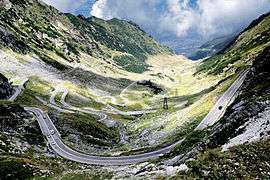 Transfăgărășan road at Făgăraș Mountains
Transfăgărășan road at Făgăraș Mountains

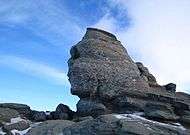 Sphinx at 2.216 m, Bucegi Mountains
Sphinx at 2.216 m, Bucegi Mountains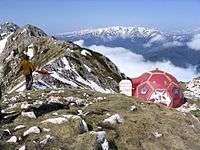 Piatra Craiului Mountains and Vârful Ascuțit Shelter
Piatra Craiului Mountains and Vârful Ascuțit Shelter
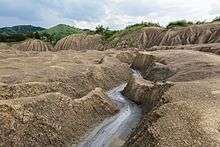
Cultural Landscapes Gallery
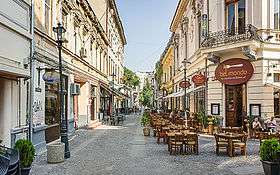 Bucharest old town
Bucharest old town Bucharest street in the 1930s
Bucharest street in the 1930s
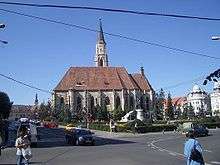
 Brașov Council Square at night
Brașov Council Square at night
_-_Clock_Tower.jpg) Medieval Town Sighișoara
Medieval Town Sighișoara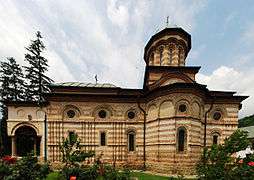

 Sibiu, the 2007 European Capital of Culture
Sibiu, the 2007 European Capital of Culture.jpg) Timișoara, the 2021 European Capital of Culture
Timișoara, the 2021 European Capital of Culture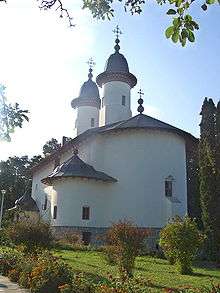 Văratec Monastery, in Northern Moldavia
Văratec Monastery, in Northern Moldavia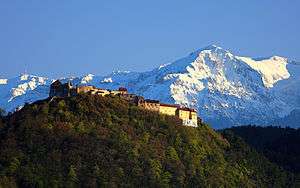
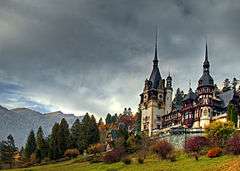
 Băile Herculane mountain spa town in Caraș-Severin County in 1824
Băile Herculane mountain spa town in Caraș-Severin County in 1824.jpg)
See also
- UNESCO World Heritage Sites in Romania
- Castles in Romania
- Protected areas of Romania
- Transportation in Romania
- Aviation in Romania
References
- 1 2 "??". Insse.ro. Retrieved 2016-11-30.
- ↑ "How important is tourism in Romania's economy?". Romania-insider.com. Retrieved 2016-11-30.
- ↑ "Agentiile de turism, la un pas de a prelua puterea". Wall-street.ro. 2005-05-30. Retrieved 2016-11-30.
- ↑ "Romania for disabled travellers". enchantingromania.com. Retrieved 10 December 2014.
- ↑ Gavrila, I.; Muntean, A. (2012). "Industrial Tourism for the Development Of Rosia Montana Area" (PDF). International Journal of Energy and Environment, volume 6.
- ↑ Merciu, C. (May 2010). "Tourist Capitalization of Industrial Heritage in Petrosani" (PDF). Geo Journal.
- ↑ Imbrescu, I. (2013). "Reviving Rural Industrial Heritage in Romania" (PDF). Conference Spain.
- ↑ Hegedus, Marius (November 2014). "Industrial and Creative Tourism Attractions in Romania". VisitFactories.
Further reading
- Tourism in the New Europe: The Challenges and Opportunities of EU Enlargement. pp. 256–265.
- "Dracula tourism in Romania Cultural identity and the state". Annals of Tourism Research. pp. 746–765.
- "Rural tourism and livelihood strategies in Romania". Journal of Rural Studies. pp. 152–162.
- OECD Tourism Trends and Policies 2012. pp. 397–402
- The Report: Romania 2008. pp. 98–100.
- Geography of Travel and Tourism. pp. 286–287.
- Yahoo News article
- The Financial Times article
- International Medical Travel Journal article
External links
| Wikimedia Commons has media related to Tourism in Romania. |
| Wikivoyage has a travel guide for Romania. |
